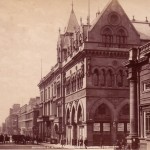 Buchanan Street was named after Andrew Buchanan, a Tobacco Lord, who envisioned that Glasgow would spread westward. With this in mind, on the 15th of February, 1763, he acquired the first portion of “five acres or thereby of ground in the Burgh of Glasgow, in the part called Palezeon’s Croft, on the North side of Argyle Street, with plots or steadings for building on each side thereof “. His plan was to take down his own mansion which was situated on Argyle Street opposite the entrance to St. Enoch Square and thereby enable access to the new street. Unfortunately, the American War of Independence ( 1775-1783 ) intervened and Andrew Buchanan lost his tobacco fortune. His business was wound up and his development plan ended up in the hands of some Glasgow bankers. Yet, in spite of this setback, his vision soon became reality and lots on the street bearing his name were progressively occupied. The first part of Buchanan Street from Argyle Street to Gordon Street was opened in 1780 and the remaining section in 1804. Initially, the street was occupied by a mixture of merchants’ villas, small holdings and some workshops but as the century progressed some very handsome buildings were erected, the first of significance being St George’s Church, now known as St. George’s-Tron Church, designed by William Stark and completed in 1808. Further fine buildings were added, including the Glasgow Stock Exchange in 1875-77, designed by John Burnet. The street acquired a reputation for elegance and specialty shopping which continues to this day.
Buchanan Street was named after Andrew Buchanan, a Tobacco Lord, who envisioned that Glasgow would spread westward. With this in mind, on the 15th of February, 1763, he acquired the first portion of “five acres or thereby of ground in the Burgh of Glasgow, in the part called Palezeon’s Croft, on the North side of Argyle Street, with plots or steadings for building on each side thereof “. His plan was to take down his own mansion which was situated on Argyle Street opposite the entrance to St. Enoch Square and thereby enable access to the new street. Unfortunately, the American War of Independence ( 1775-1783 ) intervened and Andrew Buchanan lost his tobacco fortune. His business was wound up and his development plan ended up in the hands of some Glasgow bankers. Yet, in spite of this setback, his vision soon became reality and lots on the street bearing his name were progressively occupied. The first part of Buchanan Street from Argyle Street to Gordon Street was opened in 1780 and the remaining section in 1804. Initially, the street was occupied by a mixture of merchants’ villas, small holdings and some workshops but as the century progressed some very handsome buildings were erected, the first of significance being St George’s Church, now known as St. George’s-Tron Church, designed by William Stark and completed in 1808. Further fine buildings were added, including the Glasgow Stock Exchange in 1875-77, designed by John Burnet. The street acquired a reputation for elegance and specialty shopping which continues to this day.
Jewellers flank the entrance to Buchanan Street in this view taken around 1912 from the entry to St. Enoch Square. On the left, H. Samuel occupies the ground floor corner of the Stewart & MacDonald building and on the right two jewellers, Robert Scott and Robert Stewart, have premises in the former mansion. Robert Stewart held the distinction of having been appointed Goldsmith, Silversmith and Jeweller to Queen Victoria. These jewellers would set the tone for the upscale nature of much of the business conducted in Buchanan Street. On the immediate right of this photograph at the entrance to St. Enoch Square are the premises of R. W. Forsyth. He owned two stores in Glasgow at the time, the other one being at the corner of Gordon Street and Renfield Street. ( Postcard published by E. A. Schwerdtfeger & Co., London E. C. and printed in Berlin. )
Twenty years have now passed and the jewellers and mansion on the right corner of Buchanan Street have been replaced with the fine Art Deco – inspired building, designed by H. Wilson, R.I. Pierce and N. Martin and completed in 1929. For many years it was occupied by Montague Burton Ltd., the famous tailor and Lithuanian immigrant, who started his company in Chesterfield when he was 18 and built it up to become the largest multiple tailoring business in the World during his lifetime.
It should be noted that tram and bus routes never ran along the main section of Buchanan Street nor did trams enter St. Enoch Square although many bus routes would subsequently terminate there. ( Postcard published by Valentine’s. )
The photographer would have had to set up his tripod close to the tramlines in Argyle Street in order to take this view looking north up Buchanan Street around 1905. Electric lighting has been installed outside the windows of H. Samuel, the jeweller and watchmaker on the corner, so that passers-by could browse the displays after dark. ( Postcard published by B R Ltd. and printed in Saxony. )
We have now crossed Argyle Street and are walking northwards up Buchanan Street. It was in this part, close to the Argyle Street thoroughfare, that many of the larger stores on Buchanan Street were concentrated. On the left is the ladies apparel store and furrier, MacDonald’s, and across the street are Fraser’s followed by the Jaeger wool shop and then Wylie Hill’s. Burton’s is out of the picture to our right. This photograph was taken in the 1930’s and it is interesting to note the trend to lighter colours in some of the shop fronts. ( Postcard published by J. Salmon Ltd., Sevenoaks. )
We have a good view of pedestrians and fine motor cars in this early 1930’s scene. A fashion conscious young lady is standing by the kerbside, perhaps admiring the fine Daimler with the AA badge on the grill. Fraser Sons store is on the right and beyond that is Jaeger House and then Wylie Hill’s. The awning identifies the location of Stuart Cranston’s Tea Rooms. Across the street, Wylie & Lochhead occupy the building with the bay windows. It is interesting to note in this photograph, as in the previous one, that by the 1930’s the lamp standards on Buchanan Street had been removed and the lights were now suspended from wires strung across the street. ( No publisher identified. Card postmarked 28 Feb, 1934 )
The photographer was clearly attracting a lot of interest in this scene, taken around 1910, and showing some of the fine Victorian and Edwardian buildings for which the street is famous. We are looking across to Jaeger’s the wool shop and beyond is Wylie Hill’s with examples of China and house wares in the windows. The building adjacent to it is known as the Argyll Chambers and it includes the Buchanan Street entrance to the famous Argyll Arcade. ( Note the different spelling of Argyll from the street name.) Renowned for jewellery and timepieces, the Arcade was also the location for many years of the Clyde Model Dockyard, a Mecca for modellers and young boys with dreams. Near the entrance to the Arcade is the signage for Stuart Cranston’s Tea Rooms. Stuart Cranston, a tea dealer, is credited with opening the first tea room in Glasgow in 1875, reportedly the first in the world. He certainly made a great contribution to the social life of the city. ( Postcard made in France, publisher unknown. )
This picture was probably taken in 1912-14, a few years after the previous one. Edwardian dress is still in vogue but there are now more motor vehicles in evidence. The globes enclosing the electric street lights have been replaced and a rider has been attached to Stuart Cranston’s Tea Room sign that reads Fruitarian Snack & Lunch Rooms. It is interesting that such a strict branch of vegetarianism should have been popular at the time. There was clearly a movement to promote healthy eating and also abstinence from alcoholic drinks. Several temperance hotels were present in the city, including the Waverley, which used to be further up Buchanan Street before the business was relocated to premises in Sauchiehall Street. It was Robert Cranston, the cousin of Stuart Cranston’s father, who founded the temperance hotels. ( Reliable Series printed postcard, published by W. R. & S., William Ritchie & Sons. )
This early photograph of Buchanan Street was taken around the early 1880’s and on the left is part of the recently completed Stewart and MacDonald warehouse designed by William Spence c. 1879. This fine building displays many decorative features including carved reliefs, ornamental balustrades and Corinthian pilasters, visible on the upper levels. Thomas Murray & Son, Booksellers and Stationers are located on the ground floor and in the warehouse next door is the business of David Kemp & Son. Beyond that is the new Wylie & Lochhead building, designed in three sections by James Sellars and replacing the original building on that site which was destroyed by fire in 1883. The windows on the second and third floors of the first and third sections would subsequently be modified by the addition of bay fronts. These are gaslight days and several different types of lamp are visible including a row of globes outside the premises on the right that would be replaced by a new building in 1888/89, to be occupied by Wylie Hill.
There is a real sense of movement in this 1920’s scene as people are walking, some more briskly than others, on the broad pavement past the frontage of Jaeger’s and Wylie Hill’s. Perhaps for many, the sign advertising Stuart Cranston’s tearoom in the Argyll Arcade would be a welcome sight. One man walking towards the camera is dressed in Plus Fours, where the trousers were gathered in at the knees and extended four inches below, hence the name. They were very popular as sporting attire at the time and often paired with diamond-patterned Argyle stockings. I have seen an example of this postcard postmarked 20th September, 1927. ( Publisher unknown )
We have now moved slightly further up Buchanan Street but back in time because the Argyll Chambers had not yet been built when this photograph was taken and, instead, and there is a two-story building with globes outside and a white flagpole. This was the mansion of John Reid who, inspired by European arcades, decided to start one of his own. He moved his family upstairs and set up the Argyll Arcade on the ground floor and continued it beyond the rear of his home and round to the right, through a tenement building that he owned on Argyle Street, hence the angled arcade. Stuart Cranston had a tearoom in the front of John Reid’s original house and this carried over into the new arcade when the Argyll Chambers were built between 1902 and 1904. It seems that the globes indicating the Argyll Arcade were also retained. On the other side of the street was Wylie & Lochhead’s store that specialized in furniture and carpets. ( Postcard published by J.M. Co., Caledonia Series, printed in Germany. )
Here is another view of John Reid’s mansion taken around 1900 before it was replaced by the Argyll Chambers. Outside, the globes are advertising the Argyll Arcade and Stuart Cranston’s Tea Room. The “covered wagon” parked in front of Wylie Hill’s is their delivery vehicle. ( This photograph is courtesy of the Graham Lappin Collection. )
We are now drawing close to John Reid’s mansion with Stuart Cranston’s Tea Rooms clearly indicated. Across the street is Wylie & Lochhead’s store. Notice the horse-drawn cabs with their top-hatted drivers. The only way to gain access to the shops in this part of Buchanan Street was either by cab or by walking as the tramway never ran along Buchanan Street. The Glasgow District Subway System ran underneath the length of Buchanan Street and the nearest stations were further up the street and in St. Enoch Square where they still are located today. ( Postcard publisher unknown ).
This photograph shows Wylie Hill’s store on the right with their window displays filled and next door is the recently built Argyll Chambers complete with statuary attributed to James Milne Sherriff. The architectural features of both buildings are particularly fine with the Wylie Hill building displaying an abundance of Corinthian pilasters and the Argyll Chambers featuring full Corinthian columns. An example of this postcard was postmarked DEC 9 07 so we know that the photograph was taken no later than 1907. ( Postcard published by Davidson Brothers, London )
We have now passed Wylie & Lochhead’s and the building with the high arched entry on the left, designed by Campbell Douglas and James Sellars in 1879, is occupied by the Glasgow Herald. This is a very fine building with carvings in relief on either side of the arch and Corinthian columns and pilasters rising through the first and second floors. In this 1920’s scene, passers-by are stopping to read headlines posted in the windows. Further up on the left is the Walk-Over Shoe store which would be a fixture for many years as would be Thomas Cook & Son’s Tourist Office and Bureau de Change on the other side of the lane. The sign on the lamp post is urging pedestrians to keep to the left. ( Publisher unknown )
In this scene, also from the 1920’s, the travel agency of Thomas Cook & Son is on the left of the picture, followed by the furniture store of John Reid & Son and then a curious, rather narrow building, Flemish in appearance with a steep pitched roof at right angles to the others. This property was designed by the Edinburgh-based architect George Washington Browne and completed in 1897 for Miss Kate Cranston’s Tea and Luncheon Rooms. Miss Cranston also commissioned Glasgow’s two most innovative designers, Charles Rennie Mackintosh and George Walton, to produce the interior decor and furnishings. Her business continued at that location until 1918 when the premises were occupied by a branch of the Clydesdale Bank, as shown in this photograph. Adjacent to the bank is Ciro Pearls, a very successful retailer still trading internationally, and next door is Fuller’s, a worthy successor to Kate Cranston’s and popular for teas, coffee, cakes and their own brand of chocolate. They also had an entrance in Gordon Street. The large pair of spectacles indicates the location of John Lizars, the renowned optical and photographic specialist. The firm continues in business today as Black & Lizars. ( Published by J. M. & Co. Ltd., Caledonia Series, printed in Saxony. )
This postcard is dated 25th July, 1910 and is published by William Ritchie and Sons, Ltd. ( WR&S ) in their Reliable Series.
As we continue our walk up Buchanan Street, a group of ladies in this Edwardian scene is looking at jewellery and decorative items in the windows of W. & W. Logan beside the Kodak sign. Hope Brothers, the outfitter, is adjacent, shaded by awnings, and beyond is the entrance to South Exchange Place that leads into Royal Exchange Square. On the opposite side of Buchanan Street, part of Lizars store is visible, followed by Manson’s, and Alexander & Son, before we come to Henry Burton & Co. the glover on the corner with Gordon Street. In this photograph, the resolution is such that tower and clock of St. George’s Church much further up the street can be clearly discerned. It is interesting to note the broad-rimmed extravagant hats with floral embellishments featured in this photograph that were so popular with ladies in the Edwardian era, a fashion that would soon change so radically. ( Postcard published by Judges, Ltd., Hastings. )
The fine Baroque-inspired building on the opposite corner of Gordon Street with Buchanan Street was designed by Sydney Mitchell and George Wilson and dates from 1887. At the time the photograph was taken, it was occupied by a branch of the Commercial Bank of Scotland. On the right hand side of Buchanan Street, some gentlemen have paused to look in the windows of Hope Brothers, while the man in the foreground observing the photographer appears to be carrying a cello bow. The city had recently invested in the installation of electric street lighting and used the opportunity to combine the new technology with an artistic flourish in the form of ornate standards with a wrought iron motif. In the middle of the street there is a standard bearing two lamps, a rare sight and indicative of the importance of this location. ( Publisher unknown. )
Virtually all postcard views of Buchanan Street are taken looking north, up the street. This Castle Series card is an exception and the view is directed south toward St. Enoch Square and St. Enoch Church in the distance. The rising hemlines in the ladies’ fashions point to the post-Edwardian era. Fuller’s, on the right in the picture at 99 Buchanan Street, opened in 1914. Judging from the sombre frontage of the Flemish-styled building at number 91, Kate Cranston had probably already closed her Tea and Luncheon Rooms there in 1918. Otherwise, there would have undoubtedly been some signage. There are no motorized vehicles on the street and they did not become evident until the 1920’s so the postcard probably dates from around 1919. This view was clearly taken before St. Enoch Church was demolished in 1926. It is interesting to note than men’s fashion has not changed all that much in the intervening period except that we have dispensed with hats, whereas women’s fashions have undergone many transformations.
We have now passed the junction with Gordon Street and are approaching St. Vincent Street on the left and St. Vincent Place on the right. There is a rather fine building in the foreground with an abundance of Corinthian columns and a balustrade spanning the frontage. On the right is a branch of Saxone & Sorosis Shoes which was the company’s original name, before it was shortened to Saxone. Their fine product was made in Scotland. Beyond St. Vincent Street is the Western Club building designed in the style of an Italian palazzo by David Hamilton and his son James, and completed in 1841. David Hamilton (1768-1843) is regarded as the founding father of Glasgow architecture. In this view, the buildings are obviously blackened by soot from heavy industrial pollution and they were radically transformed by surface cleaning several decades later when the original stone colour and much of the finer detail was exposed.
In this scene, we are looking at the intersection of Buchanan Street with St. Vincent Street on the left and with St. Vincent Place on the right. This photograph was taken shortly after 1900 and traffic in those days was generally sparse and slow. The fastest vehicles would be the newly electrified tramcars which crossed Buchanan Street at this location. On the left beyond the intersection are three very fine buildings in a row; the Western Club ( David and James Hamilton, 1840-41 ), the Stock Exchange ( John Burnet, 1875-77 ) and St. George’s Church ( William Stark, 1807-8 ), all of which survive to this day, albeit with extensive internal remodeling. On the right-hand side of the photograph are Queen’s Buildings and above Cairns’ Bar on the corner is the Glasgow office of the Smith Premier Typewriter Company of Syracuse, New York. The signage in the window proclaims the Grand Prix award bestowed upon the company for their Premier typewriter at the 1900 Paris Exposition. These typewriters represented the cutting edge in office equipment at the time. ( Postcard by Davidson Real Photographic Series )
In the centre of this view, a man wearing a straw boater is crossing the street and heading towards the building with signage that refers to the Paris Grand Prix of 1900. As well as introducing a new century, 1900 was an especially important year for Paris because the city hosted both the World Fair and the Summer Olympic Games. Glasgow would host its second International Exhibition in the following year. As we look up Buchanan Street, East George Lane separates the buildings on the right and the next intersection is West George Street. In the distance, as the incline increases, Buchanan Street takes a turn to the left and the taller building at the top housed the famous Armstrong’s Hotel at number 244 which afforded views both down Buchanan Street and also along Sauchiehall Street. The hotel sold modified versions of this postcard to advertise its location.
In this scene, we have come further up Buchanan Street past the Western Club and are now looking at the recently completed Glasgow Stock Exchange building, designed in a Gothic Venetian style by John Burnet Sr. and erected at the corner of Buchanan Street and St. George’s Place between 1875 and 1877. An extension to this building would later be added in St. George’s Place in 1906. This photograph, taken by George Washington Wilson around 1880, shows the view looking down Buchanan Street with the gas lamps, horse-drawn traffic and the steeple of St. Enoch Church visible in the distance. Advertisements posted on the Stock Exchange by Edgar’s, the licensed grocer, announce “New Season’s Teas”, “Fresh Ground Coffee” and “Light Summer Clarets”. Described as “Stores for the Moors”, they would appeal to the wealthy who would either own grouse moors or frequent them during the summer season. Edgar’s would be stocking the hampers ready for loading onto the MacBrayne steamer R.M.S. Columba at the Broomielaw, for shipment to the hunting lodges and hotels of the Western Highlands. On the far right of the photograph is part of William Stark’s St. George’s Church, built in 1808 when the upper section of Buchanan Street was being developed. Now known as St. George’s Tron Church, it is still very active, holding worship services every Sunday and Wednesday and engaging in community outreach.
This photograph is taken from further up Buchanan Street, near the top of the incline and close to the intersection with Cathedral Street. The view is looking south down the street with St. George’s Church visible on the right and beyond that, the Western Club. The new Stock Exchange has not yet been built, so this view predates 1875. Nearer the camera on the right is the Waverley Temperance Hotel, opened in 1840 and one of several temperance hotels that were springing up in the city where intoxicating drinks were not permitted on the premises. In the foreground on both sides of the street are commercial buildings and warehouses. On the left is George Cameron, Publisher & Wholesale Stationer, and on the right are Chalmers & Tosh, Tin and Zinc Packing Case Makers, and McLelland & Dickson, Upholsterers and Furnishers. Retail sales were concentrated at the south end of Buchanan Street and manufacturing and wholesaling at the north end. All the premises in this photograph appear to be closed and there is not a person or carriage in sight, so the scene was probably photographed early on a Sunday morning. ( Photograph courtesy of the Graham Lappin Collection. )
Buchanan Street Railway Station as seen circa 1925-1930 when it was owned and operated by the London, Midland & Scottish Railway ( LMS ). Constructed in 1849 by the Caledonian Railway Company, it would serve as that railway’s main terminus in Glasgow until Central Station was built.
Buchanan Street Redevelopment
The north end of Buchanan Street has been extensively redeveloped since 1950. It used to angle towards the left at the top and the section intruding from the right was the block between Cathedral Street and Parliamentary Road. Properties there were demolished in the early 1950’s to make way for the N.A.A.F.I Building ( Navy, Army and Air Force Institutes ) which provided facilities and goods to British servicemen and their families. Some photos of the building are posted in a discussion thread on the excellent Urban Glasgow website http://urbanglasgow.co.uk/archive/people-and-places-discussion-thread__o_t__t_1039.html The N.A.A.F.I. was not in operation for long before it was taken over by the Reo Stakis organization in 1964 and turned into a casino. During the late 1970’s, the construction of Buchanan Street Bus Station resulted in a rearrangement of roads in the area. The western part of Parliamentary Road was realigned in an approximate east-west direction between North Hanover Street and West Nile Street and was renamed Killermont Street. The buildings along the eastern part of Parliamentary Road were cleared to make way for a new council housing development. As for the casino, it was reported to be still standing in 1985, but was subsequently removed to allow construction of the Glasgow International Concert Hall which was completed in 1990 and renamed the Glasgow Royal Concert Hall upon the granting of Royal Status. The Buchanan Galleries development came later, Buchanan Street was straightened out and the mall built over Cathedral Street. The Galleries opened to the public on 31 March, 1999. During this collective redevelopment, the area that used to be occupied by the western part of Parliamentary Road was built over.
Legends © Christopher J. Jones
Except where otherwise stated, all photographs are from the author’s collection.
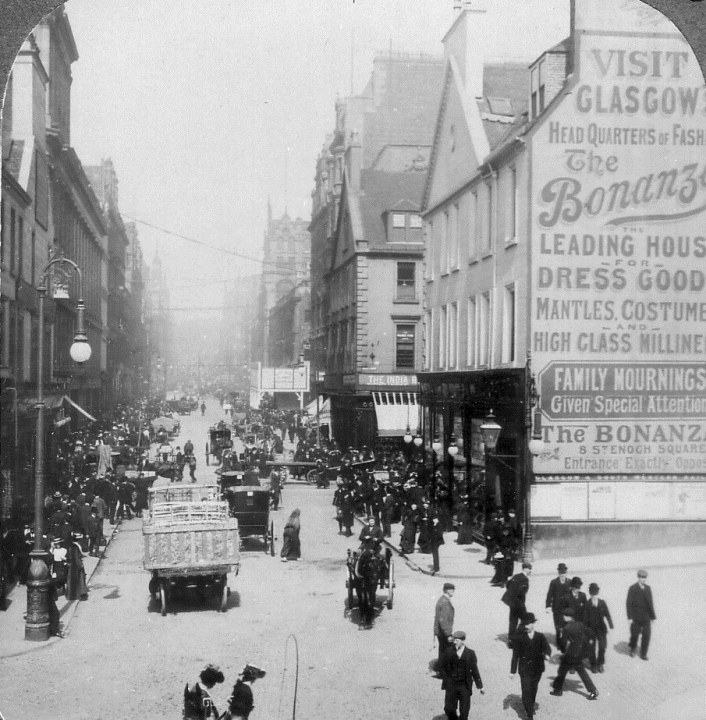
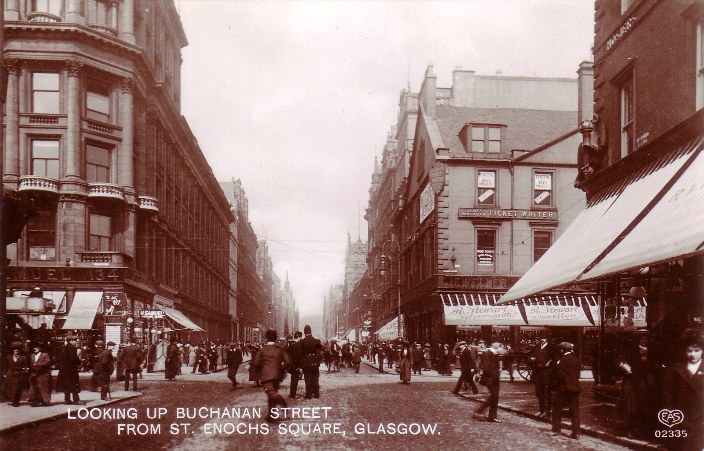
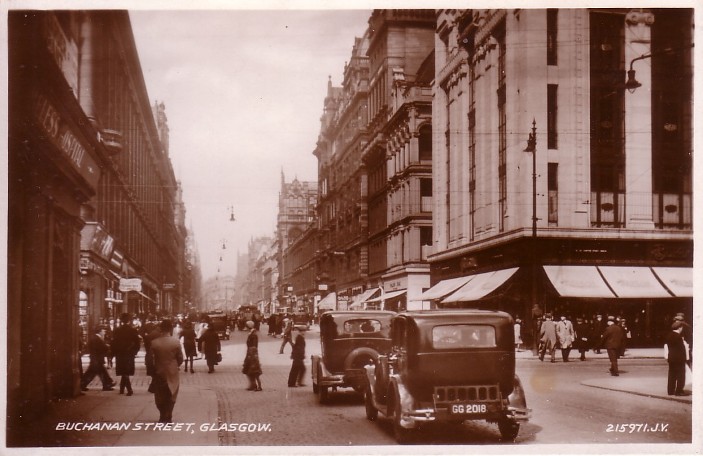
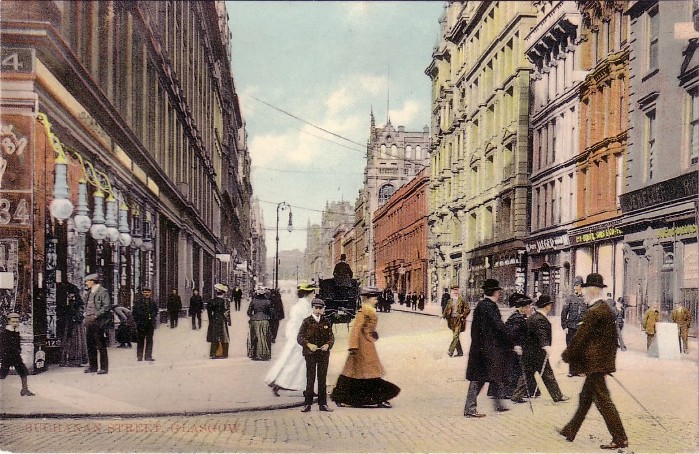
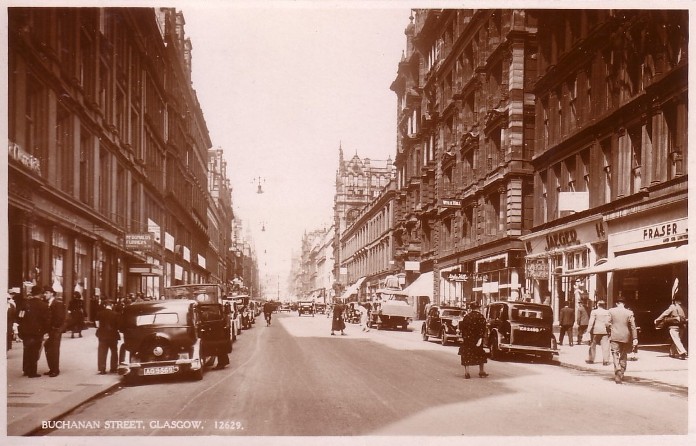
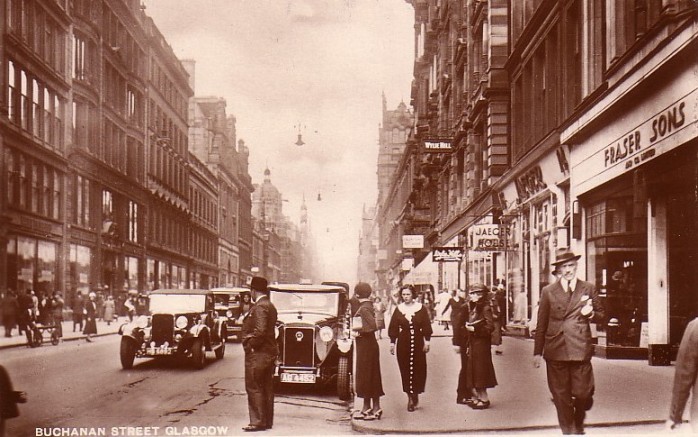
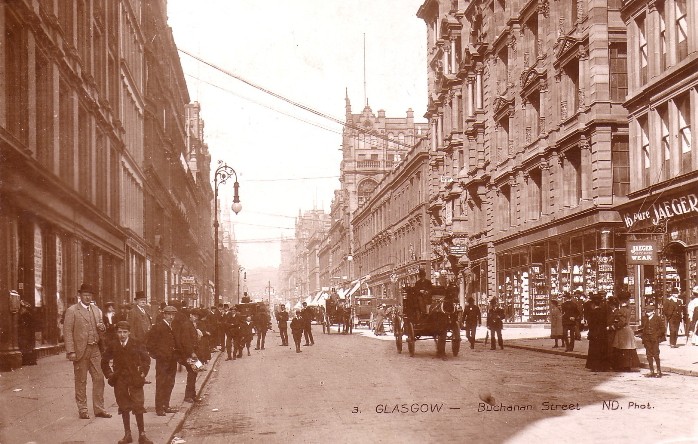
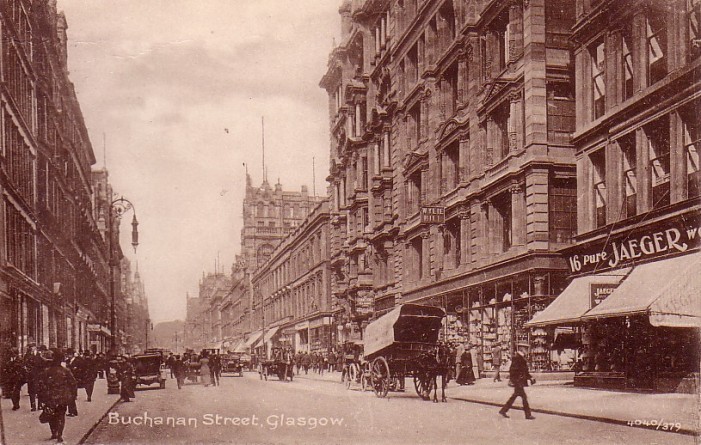
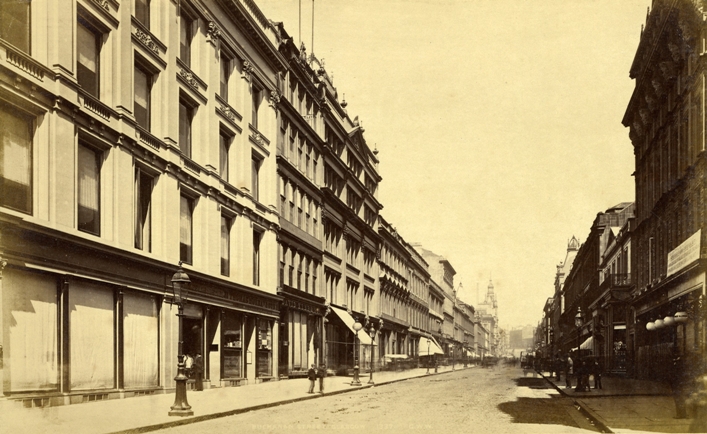
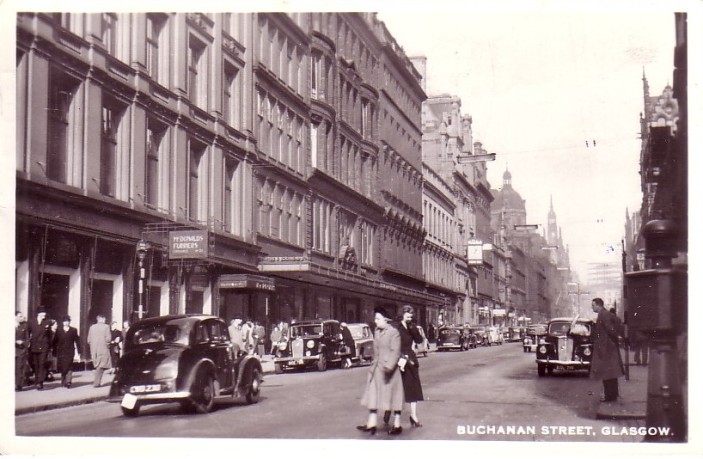
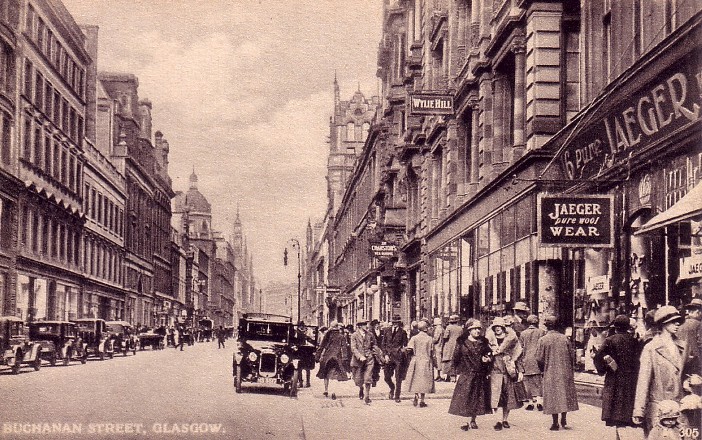
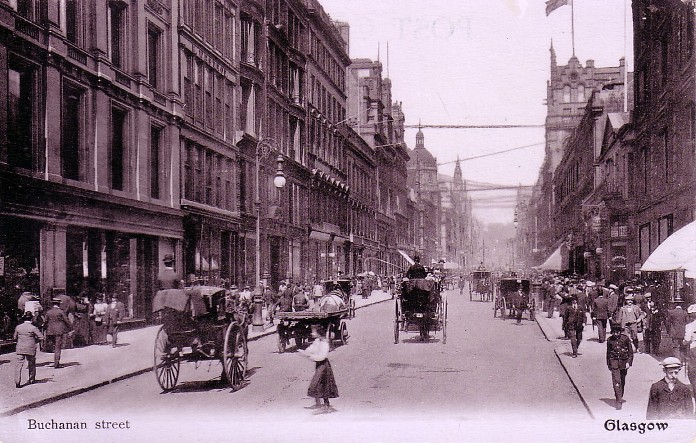
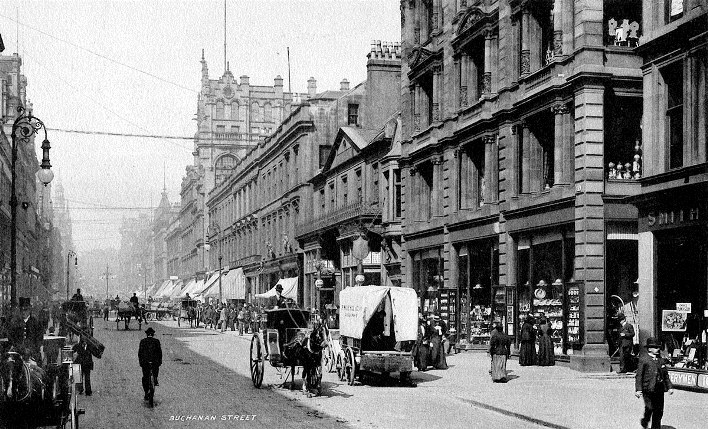
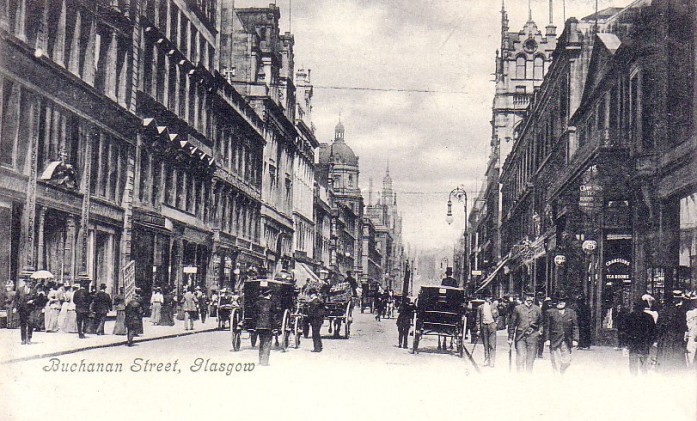
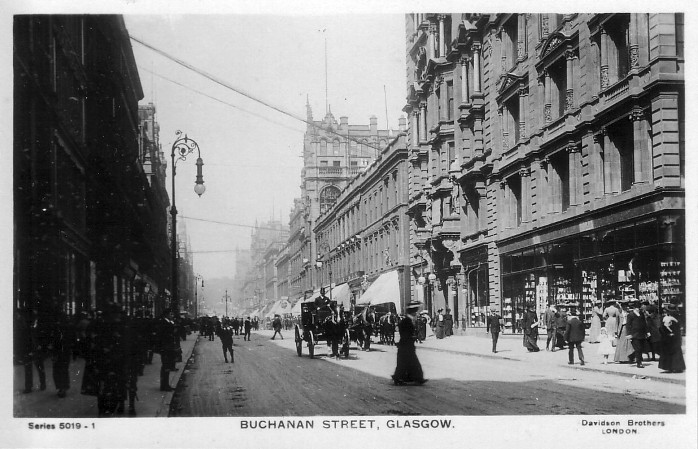
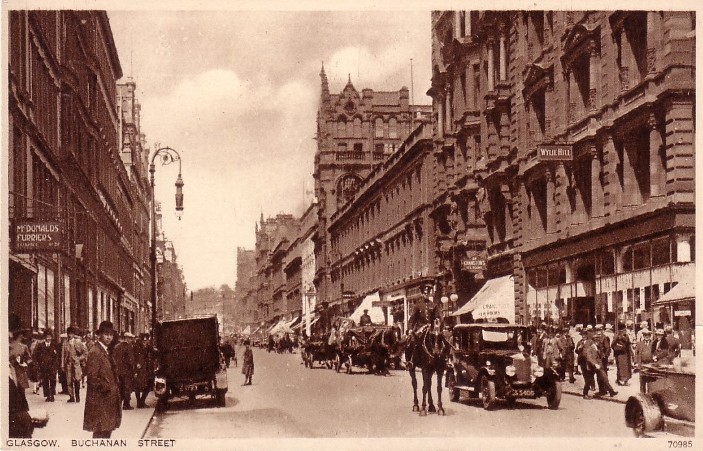
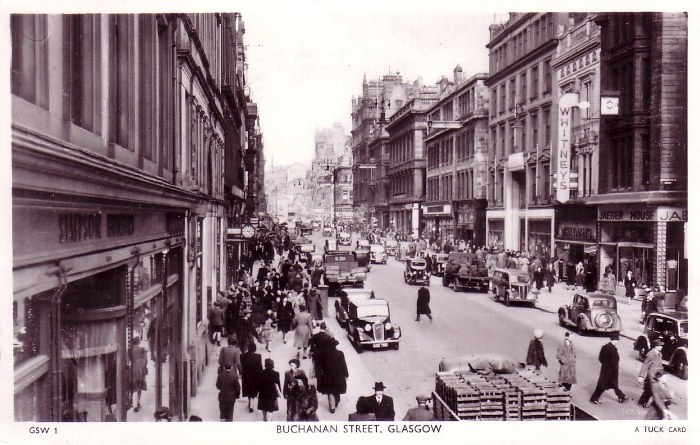
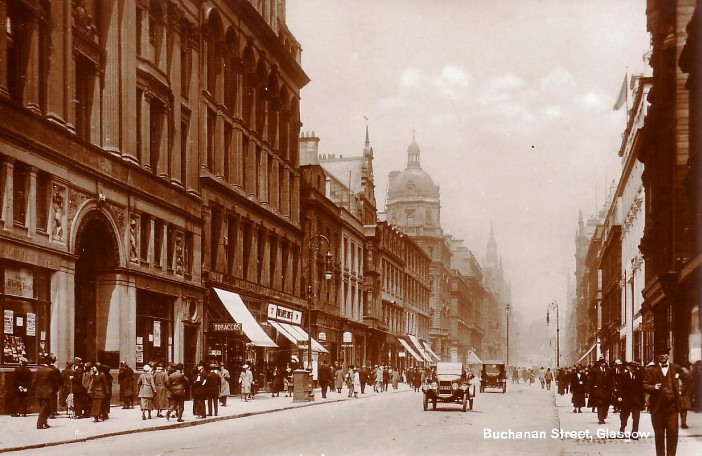
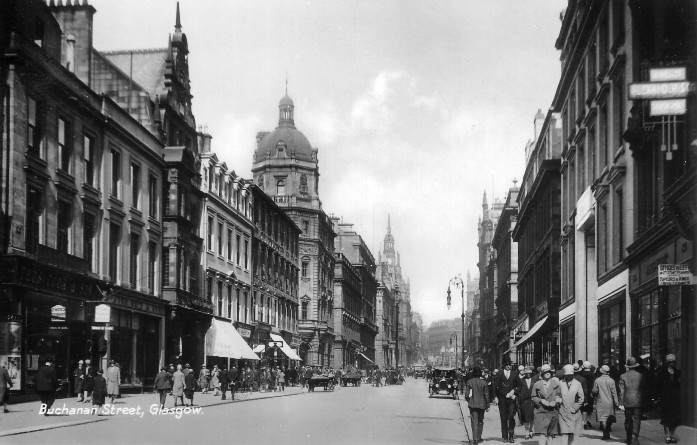
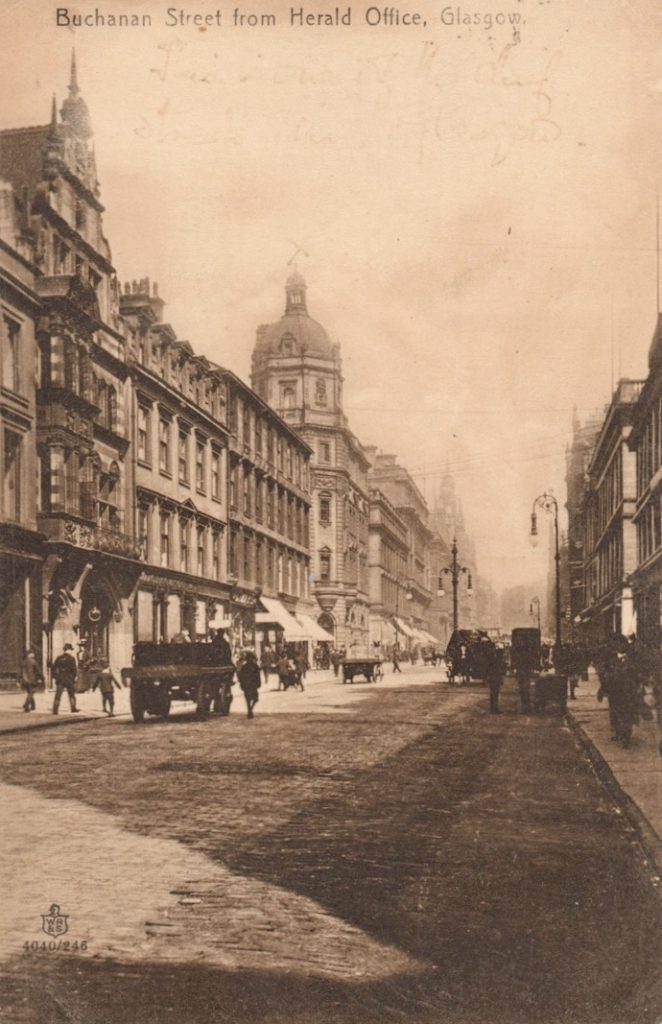
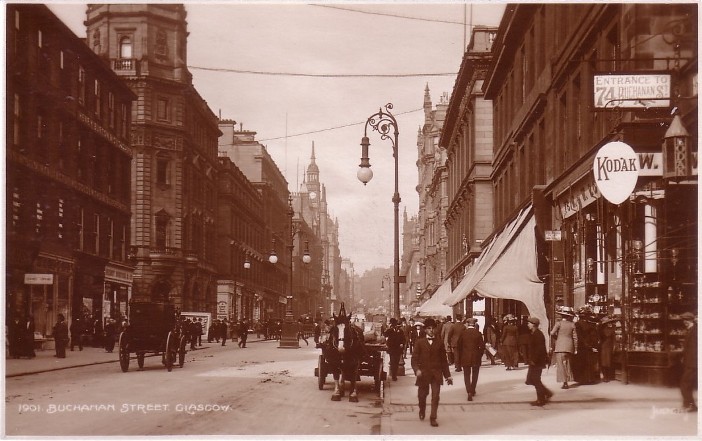
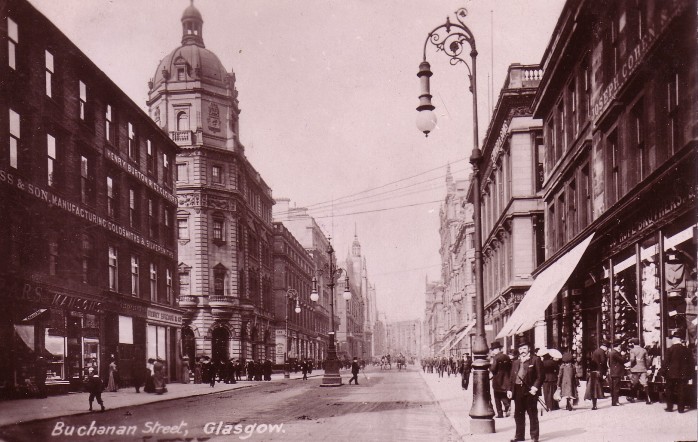
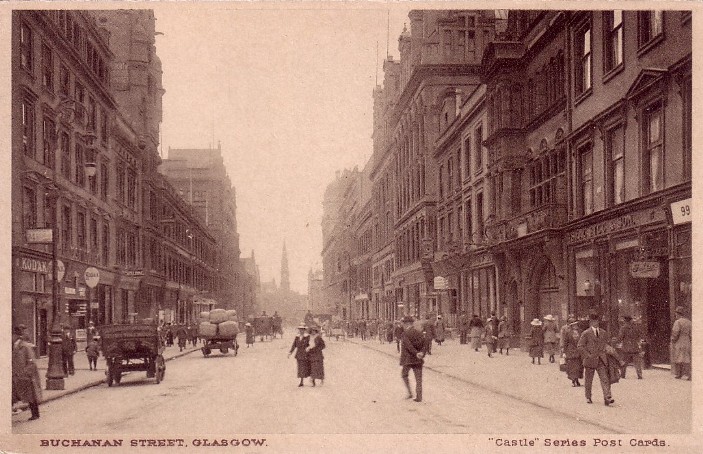
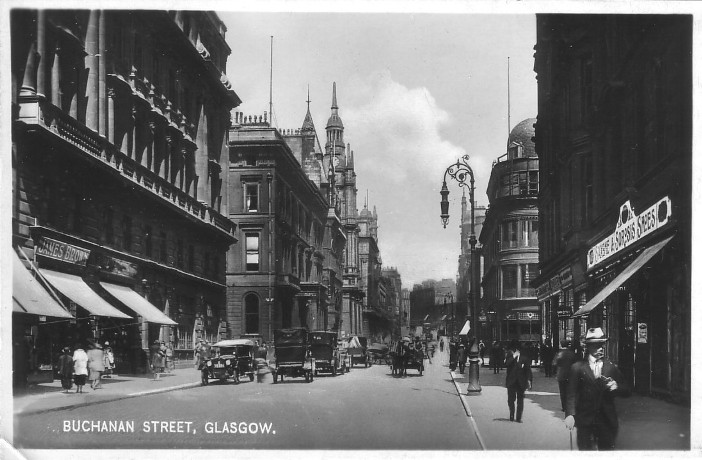
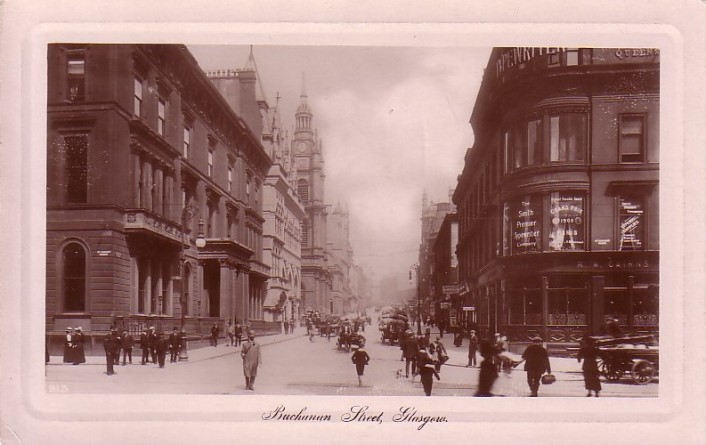
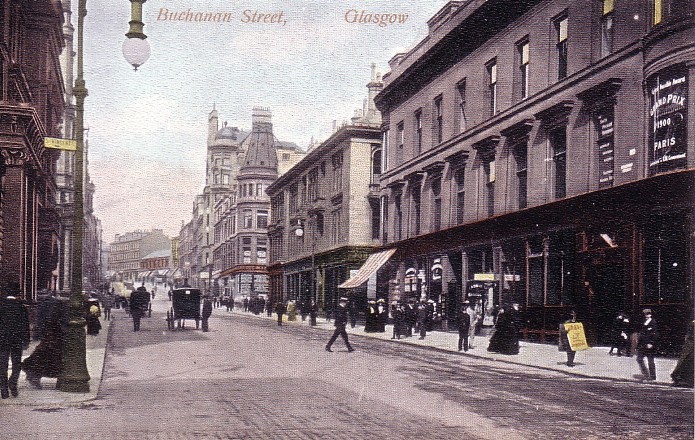
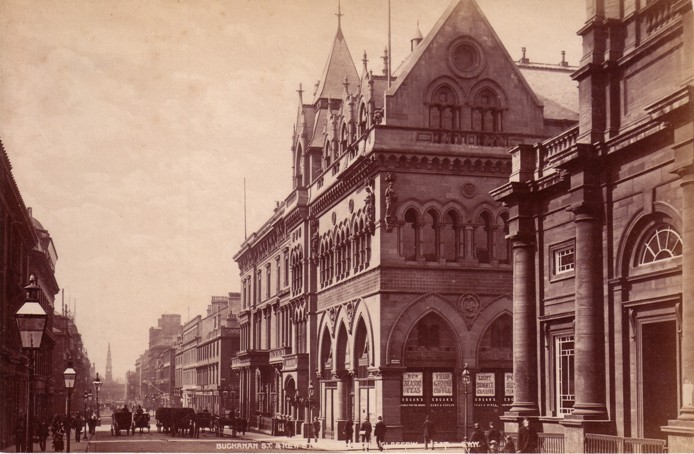
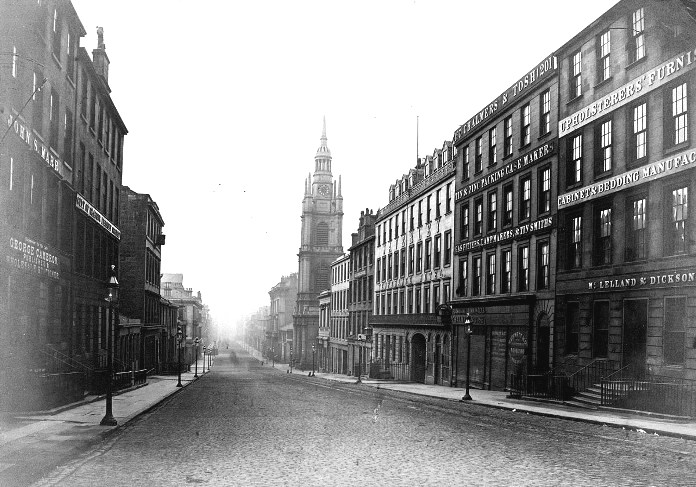
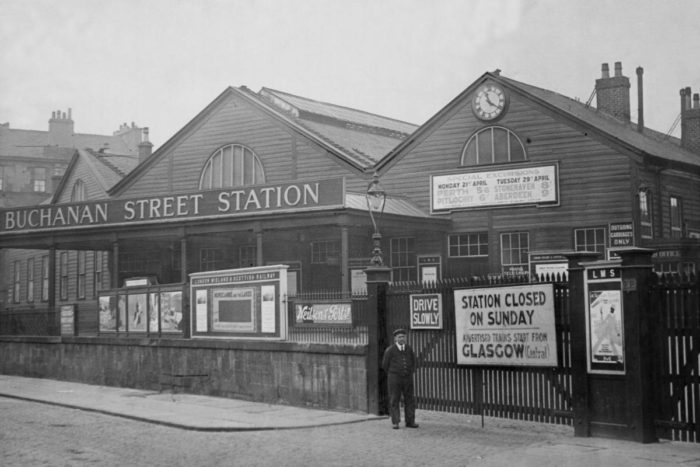

{ 2 trackbacks }
{ 78 comments… read them below or add one }
Thanks for your comment. As you can see, the website is a work in progress.
Nice website. Sorry to be pedantic, but you comment, in the 4th picture of Buchanan Street in the 1920’s, that the man is wearing Oxford Bags, which were very popular in the period. They were indeed – but the young man, with the short trousers gathered at the knees, is wearing PLUS FOURS. Oxford Bags were full length and unfeasibly wide at the bottom, with turn-ups. Keep up the good work!
Thank you for pointing this out Jane and I have now corrected the mistake.
Hi, I love looking through the photos of old Glasgow. I’m particularly interested in the area where the Buchanan Galleries now stand as they went up when I was about 8 or 9 and I really can’t remember what stood there before! I was wondering if any photographs remained from around that area. Thanks, Jamie
Yes Jamie, there are some photos and I am in the process of trying to obtain permission to use them. The upper end of Buchanan Street was not photographed as much as the lower and middle portions which received more attention from shoppers. I plan to post more information on the upper part of the street soon.
Jamie, here is some further information about the redevelopment around the top of Buchanan Street.
The north end of Buchanan Street has been extensively redeveloped since 1950. It used to angle towards the left near the top of the street and the section intruding from the right lay between Cathedral Street and Parliamentary Road. Properties in that block were demolished in the early 1950’s to make way for the N.A.A.F.I Building ( Navy, Army and Air Force Institutes ) which provided facilities and goods to British servicemen and their families. Some photos of the building are posted in a discussion thread on the excellent Urban Glasgow website http://urbanglasgow.co.uk/archive/people-and-places-discussion-thread__o_t__t_1039.html The N.A.A.F.I. was not in operation for long before it was taken over by the Reo Stakis organization in 1964 and turned into a casino. During the late 1970’s, the construction of Buchanan Street Bus Station resulted in a rearrangement of roads in the area. The western part of Parliamentary Road was realigned in an approximate east-west direction between North Hanover Street and West Nile Street and was renamed Killermont Street. The buildings along the eastern part of Parliamentary Road were cleared to make way for a new council housing development. As for the casino, it was reported to be still standing in 1985, but was subsequently removed to allow construction of the Glasgow International Concert Hall which was completed in 1990 and renamed the Glasgow Royal Concert Hall upon the granting of Royal Status. The Buchanan Galleries development came later, Buchanan Street was straightened out and the mall built over Cathedral Street. The Galleries opened to the public on 31 March, 1999. During this collective redevelopment, the area that used to be occupied by the western part of Parliamentary Road was built over.
You say that the baroque building on the corner of Gordon Street was occupied, when the photograph was taken, by the National Commercial Bank of Scotland. However, as this bank did not come into existence until 1959, at the time of the photograph it must have been occupied by either the Commercial Bank of Scotland or the National Bank of Scotland which merged to form the National Commercial Bank of Scotland.
Thank you for pointing this out. According to the 1927 Glasgow Directory, the property at 113/115 Buchanan Street on the corner with Gordon Street was occupied by the Commercial Bank of Scotland. I have now made the correction.
How can we get permission to use your images for Buchanan Street?
What are the requirements? Do you have anymore images?
I will contact you by email and you can let me know what you have in mind. You may need high resolution scans.
Chris,
Thank you for sharing fantastic information on Glasgow. I recently acquired some beautiful old chairs manufactured by John Reid & Son, 89 Buchanan St, Glasgow. Do you have any information on such a manufacturer?
Jeff
Chris,
Like a prior post, I would love to acquire a high resolution scan of one or two of your photos for the John Reid mansion on Buchanan St. Is this possible?
Jeff
Hi Jeff,
Thank you for your comment. John Reid & Son occupied premises on the west side of Buchanan Street adjacent to Thos. Cook which was just north of Mitchell Lane. In the photo below, you can see Thos. Cook on the far left at number 83 Buchanan Street, then John Reid & Son at number 89, followed by the Clydesdale Bank at number 91 ( the former premises of Kate Cranston ). The awning beyond the bank is serving to shade Ciro Pearls and then beyond that is Fuller’s Restaurant and then John Lizars, the optical and photographic specialist. It seems that John Reid & Son were involved in both the manufacture and sale of fine furniture. It is possible that this John Reid might have been related to the owner of the mansion on the other side of the street but they are not one and the same. The mansion owner lived much earlier and was a timber merchant.
Hi Jeff,
No problem. I can send you scans of the mansion and the furniture shop.
Hi Chris,
Again, thank you for the great information and for the coming scans. Knowing where my chairs originated is interesting. I live in the United States and I was not familiar with Glasgow. Based on your excellent photos and discussion, I would love to visit Glasgow.
Jeff
I have been trying for some time to find out if around 1935/37 there was such a place as Buchanan Street. On my mother’s birth certificate, it states that her mother was a kitchen hand in Buchanan Street. Were there any dwellings along that street at that time that would have been a large house with staff? I would dearly love to find out as we know little of my mother’s family.
Johanne
Hi Johanne,
Thank you for your enquiry. By the time of your mother’s birth, there were no residential mansions left on Buchanan Street. They had all been replaced by commercial premises. There were several hotels, the Ivanhoe ( 185 Buchanan Street ), the George Hotel ( 235 ), the Popular Commercial Hotel ( 257 ), the London Commercial Hotel ( 288 ), the Imperial Hotel ( 244 ), the Palace Hotel ( 222 ) and these would have employed kitchen staff so your maternal grandmother may have worked there or possibly at the Athenaeum Restaurant or the Western Club. The hotels are long gone but there is still an Athenaeum and the Western Club has moved to Royal Exchange Square. There may also have been kitchens in some of the larger stores on the street such as MacDonald’s and also at Fuller’s Restaurant so there are many possible places where kitchen staff would have been employed.
Hi Jeff,
You’re welcome and I have sent the scans via email. Glasgow has a very distinguished history in so many fields; architectural, ecclesiastical, economic, industrial and scientific. It’s people have been described as “warm-hearted, stubborn in their loyalties and aggressively proud”. You would be very impressed. Thank you again for your interest.
Chris
Hi Chris
I wonder if you could help me as I am looking for a Black/White Canvas Picture of Glasgow City Centre. This is a present for my Mother she was born in Glasgow in 1925 and now lives in Derby, I was looking for somewhere around 1945 when she was a Clippie on the Buses. I was looking for areas Sauchiehall St, Argyle St & Buchanan St for when she was a young woman. Appreciate if you can help – Thank you
Hi Rhona,
Thank you for your enquiry. I could send you a high resolution scan of a street scene in the mid to late 1940’s and perhaps you could have a canvas prepared from that. Argyle Street and Sauchiehall Street were mainly served by trams at that time. Do you know if your Mother was a clippie for a few years and at which depot(s) she was based? Also, did she work solely on the buses or did she also serve on the trams? She would certainly remember the trams. The trolleybuses were introduced in 1949. I could try to find a photo illustrating a route with a vehicle type on which she might have served.
Hi Chris
Thank you very much for your reply I shall have to try and find further information from my Mother and I shall get back to you in the very near future with some details
Thank you again
Hi Rhona,
You’re welcome. See what you can find out without giving the game away.
Chris
On a recent trip to Glasgow we greatly admired a building (next to the Athenaeum) with the name ‘Townhouse’ on the outside. I have been trying to trace the history of this building. Can you help? Does it have a musical connection?
Anne
Thank you Anne for your enquiry and the very fine building to which you refer was designed by Alexander Paterson and completed in 1909 for the Glasgow Liberal Club. It is located on the corner of Buchanan Street and Nelson Mandela Place, formerly known as St. George’s Place. In 1928, the property was acquired through the generosity of Sir Daniel Stevenson and other benefactors for the Scottish National Academy of Music which later became the Royal Scottish Academy of Music and Drama, so there was indeed a musical connection. The Academy remained there until 1987 when they moved to new premises at 100 Renfrew Street and the original building was subsequently purchased and extensively renovated. It was renamed the Townhouse and is now a centre for specialized retail.
Chris
Hi Chris,
I am interested in the postcard from 1901 of Buchanan Street showing the Kodak sign and entrance to 74 Buchanan Street. My grandfather worked for Kodak at the time as an assistant chemist. I am researching him on behalf of my family and hope to put together a photo book of him and the family. Can you let me know if it is possible to have a copy of the postcard to use in our photobook please?
I really love your site and often have a look at the photos and information.
Best wishes.
Janet
I must say how much I enjoyed reading your pages.
I’m doing some research on a large piece of pottery I found in my mum’s croft. It has the name Manuel & Webster, Buchanan Street, Glasgow on it and research so far indicates they were located at number 133. Do you have any information on this street number?
Kind regards
Ivy
Hi Janet,
Thank you for your interest in the website and I will be happy to send you a high resolution scan of the photograph in question.
Best wishes,
Chris
Hello Ivy,
Thank you for your comment and enquiry. There is an entry in the Edinburgh Gazette, dated November 18, 1898, announcing the retiral of James Manuel from the firm of Manuel & Webster, Italian Warehousemen and Wine Merchants, at 133 Buchanan Street, Glasgow. Here’s the link: http://www.edinburgh-gazette.co.uk/issues/11041/pages/1167/page.pdf
Kind regards,
Chris
Hello Chris
Thank you so much for the scan, it will be great for our photobook. Since my grandfather died before any of my cousins or I were born, it has been great to piece together bits of information about him, and this picture will help us so much.
Best wishes.
Janet
Hello Chris,
I have very much enjoyed your site. I am currently pursuing my Master’s in Urban Geography at Utrecht University in the Netherlands. In April, my colleagues and I will be travelling to Glasgow for an excursion. I was hoping to ask you a few questions regarding this trip. Is there a way I can reach you via email?
Warm regards,
Mary
Hello Mary,
Thank you for your message and I will be in touch. I wish you well in your studies.
Best regards,
Chris
Hello Dr. Jones,
I am a final year Civil Engineering student, partaking in a project to roof part of Buchanan Street. For this, I am carrying out a short historical account for the street (literally 2 pages long) and I was wondering if I could get permission to copy some of the photographs you have on this excellent article?
I was also wondering if you could point me in the direction of some literature on the matter, or if you have any sources that you used?
Apologies if this seems untoward, I am just wary of referencing correctly. Internet articles seem to be frowned upon and I need to quote the source!
Thank you for your time!
Kind regards,
Paul Carruthers
Hello Paul,
I appreciate your interest and you are welcome to use any of the photos and quote this site as a reference. If you need a high resolution scan of a particular photo, just let me know. Material from this website has been referenced in academic work and is being used in current research projects as you will see from some from the comments. The Internet is a great resource and if ever I make an error I can usually rely on a reader to correct me. You may see a few examples of this. I presently live far from the great city where I was raised and so have built up a reference library and photographic archive. I rely on this material as well as my own experience and information obtained online. As you are currently in Glasgow, you might want to check out the resources of the Glasgow Room at the Mitchell Library.
By the way, which part of Buchanan Street are you planning to roof?
Kind regards,
Chris
Hello,
I really enjoyed looking at the pictures. My brothers can remember going through Glasgow on trams when they were on their way to school and my Mum had my oldest brother at the famous Rottenrow Hospital.
Donna
Thank you for your fascinating history of Buchanan Street. My great great grandfather was David Kemp who started a ‘shawl emporium’ at 37 Buchanan Street which remained in business under various guises until about the First World War. I can see one image with the David Kemp premises but I’m wondering if you have any more information at all.
Kind regards, Yolanda
Hello Donna,
Thank you for your comment. For many years, Rottenrow was the location for the Glasgow Royal Maternity Hospital which had a superb reputation.
Regards,
Chris
Hello Yolanda,
Thank you for sharing this information. I cannot add to your comment at the present time but will certainly be in touch if I come across anything.
Best wishes,
Chris
Fantastic looking at the pics. Also, you have settled a family argument. My aunt said there was a large store where Fraser is now but I and another aunt disagreed. Your pics have proved us wrong and we will have to eat humble pie now.
Christine
Glad to be of service Christine.
Thank you for your comment.
Chris
Hi,
I recently bought a lovely old cardboard box from a charity shop. It has writing on the front for Edward & Sons, The Jewellers and Silversmiths Company, Show Rooms 92 and 96 Buchanan Street. I don’t know how the box ended up in Hay on Wye in Wales but I would be happy to send an image of it to you if you are interested. I have never been to Glasgow but I love the box because of the typography.
Becca
Hi Chris,
I am looking for info/photo Aird, Thomson & McKellar, Jewellers and Silversmiths, 133 Buchanan Street circa 1870 – 1920. Peter McKellar was a partner in this firm until he retired in the 1940s.
I was intrigued by the info you gave to Ivy. “There is an entry in the Edinburgh Gazette, dated November 18, 1898, announcing the retiral of James Manuel from the firm of Manuel & Webster, Italian Warehousemen and Wine Merchants, at 133 Buchanan Street, Glasgow.”
Was this address an arcade? Or perhaps the Jewellers bought the property. I look forward to your reply.
Kind regards
Hazel
Hello Hazel,
Thank you for your inquiry and I have checked the Glasgow 1927 Directory which is available online http://freepages.genealogy.rootsweb.ancestry.com/~glasgow/1927address789.jpg There is only one business listed for 133 Buchanan Street and many for number 135 as you will see. Aird, Thomson & McKeller are not listed but this was a few years after the interval you gave me. There is a John A. Aird listed at 125 Buchanan Street and I will let you know if I find anything further. I’m not currently in Glasgow otherwise I would check the resources at the Mitchell Library.
Best wishes,
Chris
Hi Chris,
There was a hotel at the top of Buchanan Street Glasgow in the 1970’s, which has now been converted into shops, one of which is HMV. Could you please tell me the name of this hotel and do you have any 1970 photographs of it? It would mean a great deal to me.
Regards, Jean
Hello Jean,
The hotel to which you refer was the George Hotel at 235-245 Buchanan Street and original facade has been retained. I will check to see if I have any photographs of the building when it was the hotel.
Best wishes,
Chris
Hi Chris,
My great-grandfather’s family (including my grandfather) are listed on census records as living at 252 Buchanan Street in 1881. I would be very interested to know what kind of building they lived in and whether it still exists. They were not wealthy people so I would imagine they lived over a shop, or something. My great grandfather is listed as a coach trimmer and my grandfather would have been about 8 years old at the time. If you have anything about this address, I would be very interested. Thank you.
Ali
Hi Ali,
Thank you for your inquiry. Since 1950, the north end of Buchanan Street has been extensively redeveloped. The address to which you refer used to be on the right-hand side of the street near the top, in the block between Parliamentary Road and Cathedral Street. You can see this block coming in from the right at the top of the street in some of the photos. Properties there were demolished in the early 1950’s to make way for the N.A.A.F.I. Building ( Navy, Army and Air Force Institutes ) which provided facilities and goods to British servicemen and their families. Further developments occurred after this and they are detailed in my response to a question earlier in this discussion thread.
I did some searching and found that a photographer, John H. Waddell, was at 252 Buchanan Street in 1895. He may have occupied the premises on the ground floor and there were probably residential flats above, sharing the same address. I hope this helps.
Best wishes,
Chris
Hi Chris,
I spent the first three years of my working life in Buchanan St., from 1966 until 1969, firstly at Rowans Mens’ Outfitters as a “junior assistant”. The premises are still visible today as Rowan House, and the company in its heyday dressed the hoi polloi of Glasgow. It must surely have been the template for “Are You Being Served”, and employed the same wonderful mix of retail eccentrics that the fashion trade seemed to attract then.
I lasted a month there, and then moved to Jaeger House, same job title, but an extra 10 shillings a week, and trendier clothes. The menswear dept. was in the basement, and it gave a rough idea of how troglodytes felt. Jaeger was privately owned then, and had the whole building, leasing out floors to companies like Alitalia, whose stewardesses called in often, and seemed so unattainably glamorous compared to our mundane jobs. The building is now home to Russell & Bromley, but take a look up and see what a fabulous building it is, with some fine carvings. A favourite treat was a Fullers bun, from the eponymous bakers opposite. This huge choux pastry, cream and chocolate confection would feed a family of six, but did little to increase the girth of this 19 year old at the time. Three of the happiest years of my life,
Willie
Hi Willie,
Thank you very much for sharing your experiences as a young man starting your working life in Buchanan Street. It’s accounts such as yours that make the Glasgow experience come alive. The facade of Rowan House is certainly impressive and the company specialized in mens’ and boys’ clothing. I believe they also supplied school uniforms. Rowan initially occupied premises in Argyle Street, before moving to 68-74 Buchanan Street. I can certainly appreciate the contrast in styles offered by Rowan and Jaeger. Your extra 10 shillings a week at Jaeger’s would go a long way, and the glamour of visiting Italian stewardesses would provide an added bonus. Thanks again Willie.
Best wishes,
Chris
In the last photograph there is mention of George Cameron, Wholesale Publisher. From my family history research, he traded from that address between 1855 and 1860 before his brother John Cameron took over the business and moved it to another address (which subsequently became Cameron, Ferguson & Co in 1872). The photo can therefore be dated to between 1855 and 1860.
Robert
Hello Robert,
Thank you for providing this information.
Best wishes,
Chris
Dear Chris,
I am currently writing the family history of “Life and Times” of my husband’s mother Janet Nicoll, nee Cameron. As Janet was born in 1897 and lived until she was 82, she would have seen many changes in her lifetime. One family highlight was when the family visited His Lordship’s Larder at 10 St. Enoch Square. This sojourn was preceded ( or followed ) by a visit to H. Samuel, the Jewellers at Exchange Square, where Harry ( Janet’s husband ) would check the accuracy of the pocket watch which he wore in his waistcoat. As you will appreciate, the photograph on your website of “Looking up Buchanan Street from St Enoch’s Square, Glasgow” taken around 1912 ( bottom r.h. corner has EAS:02335 ) is a perfect illustration of what the family would have experienced.
Is it possible for me to have permission to reproduce the photo in the booklet I will be producing? It is strictly a family project with a maximum of 20 booklets being produced on my own home printer. I would, of course, give full acknowledgement to you and your website.
It would mean much to me to be able to include the photo in the booklet which is being created so that my grandchildren will have a better and more personal insight into their family’s life in the 20th century.
Thanking you in anticipation for your assistance,
Best wishes,
Penny Nicoll
262 Old Pacific Highway, Swansea, NSW, 2281
Dear Penny,
Thank you very much for sharing this information about your husband’s family and you are most welcome to use the photograph, and any others, in the booklet which you are preparing. The premises of H. Samuel, the jeweller, were located at 134 Argyle Street / 1 Buchanan Street and are visible on the left-hand side of the photograph to which you refer.
Best wishes,
Chris
Hi Chris,
Your photographic collection of historic pictures of Buchanan Street is excellent and very informative especially when one looks at the situation today. I was wondering if you had any pictures of the Morrison’s dress shop and the adjacent shop which were demolished to make way for the copper clad Office Building for BOAC.
Thanks in advance for any information you may be able to give me.
Kind regards,
Alex Macgregor
Hi Alex,
Thank your for your comment and inquiry. The former BOAC building to which you refer is located at 83-85 Buchanan Street, on the west side of the street, immediately north of Mitchell Lane. There are several very good photographs of the copper-clad building and its location at http://www.architectureglasgow.co.uk/midcity.boac.office.html I don’t know about Morrison’s dress shop previously occupying this location but the two businesses listed in the 1927 Glasgow Directory were Thomas Cook & Son at number 83 and Lawson & Co., Ltd at number 85. John Reid’s furniture store was located at 89 Buchanan Street just before the Clydesdale Bank building, which was formerly one of Miss Kate Cranston’s tearooms. The location of these businesses can be seen in the 18th and 19th photographs of this chapter.
Best wishes,
Chris
Hi Alex,
Morrison’s was a top end ladies fashion wear shop, and was certainly trading during my stint at Jaeger between 1966/69. I think it was double fronted from memory and was independently owned, but eventually came under House of Fraser ownership. It sold “older ladies” fashion wear, and “mother of the bride” outfits”, but I think eventually fell out of fashion, or the “older ladies” had all died off. A lovely shop though.
Willie.
In the mid sixties BOAC felt that the city plot they had acquired and wanted to develop for office premises was too small for the accommodations they envisaged for themselves so they tried to convince Morrisons, the elegant dress shop to do a joint BOAC/Morrisons development. As you can imagine, the economic disparity between the two companies made this an impossibility and the joint development proposal fell by the wayside. Some drawings for the double site proposal were prepared but not by me and I have no idea what happened to them. In the Summer of 1966, I was asked by Isi Metzein to prepare a design for the BOAC Office Block on a single plot rather than the earlier proposed double plot, which I did. The design lay around for a year until 1967 when I was again asked by Isi to build a model of the proposed building. The reason given me for this was that the Chairman of BOAC at the time, Sir Giles Guthrie, apparently experienced some difficulty in reading architectural drawings. I built the model and took it down in my car to Prestwick Airport which BOAC were using for their cargo operations. Guthrie wanted the model as quickly as possible as he was now both anxious and very keen to get on with the project. The model was given to a BOAC pilot by me for expeditious delivery to London and the Chairman. I have photographs of the model, of course, as well as the original design drawings.
Incidentally, I wanted to use stainless steel cladding and the repetitive small window units were a small genuflection by me to Gardners Warehouse, a building which has always impressed me. There are a number of other modifications to the original design all done by Isi not the least of these being his decision to use copper for the cladding and also to downgrade the tall three storey glass fronted entrance I had proposed.
Hi Chris,
I was wondering where I could get information regarding a shop that used to be located at
75 Buchanan Street. It was an opticians called L. Campbell. I have a very old pair of round, wire-framed spectacles of the style worn by Gandhi, in a hard case with the opticians name and address on it.
I’m just curious to date these, hence trying to find the period when the shop would have been there. Are there likely to be any records kept with the Council, or do you think that there may be some Land Registry records going back that far? Any information would be very appreciated.
Many thanks,
Graham.
Hi Graham,
Thank you very much for your inquiry. I have checked the 1927 Glasgow Directory which is available online but could find no record of an L. Campbell at 75 Buchanan Street. You could try contacting the Mitchell Library to see if they have Glasgow Directories before and after that time. Spectacles of the type you describe may have been produced during the Victorian era.
Best wishes,
Chris
Hi Chris
Would you know what businesses were at 140 and 150 Buchanan Street around 1853 – 57?
I have a hand written recipe book with the name Miss Catherine McLallum, and these addresses appear against recipes, as though she was working at these addresses at the time. She also records ‘Bank House’ too.
Thanks
Lesley
Hi Lesley,
Thank you very much for your question. The addresses you give would have been on the right-hand side of Buchanan Street, in the part leading up to the present intersection with West George Street, and across from St. George’s Church. The Church was completed in 1808 but the Stock Exchange would not be added until 1877. Perhaps the addresses in your recipe book were those of private residences, merchants’ villas where staff would have been employed. If I find out anything further, I will certainly let you know.
Best wishes,
Chris
Chris – A fascinating set of postcards ( I have a family collection and know what priceless gems they can be). With your extensive knowledge of Buchanan Street, can you help with Russ & Co, manufacturing furriers with a shop 50, 52 & 54 Buchanan Street founded and run by German immigrant Frank Henry Russ. F. H. Russ established the business c.1878, and he and his growing family gained British Naturalisation in 1881. (His older brother Charles – my great-grandfather – had a successful shop in New Bond Street, London). FH was very successful but died far too young in 1888, and his brother also died very young in 1893. (Manufacturing furriery was not a healthy business behind the fine furs and grand shops!)
Thank you for any help you can provide.
Carolyn Findell (Dorset)
Hi Chris,
I’m a Glaswegian and I love reading the history of the city. Recently, I managed to buy a set of Arts and Crafts teaspoons from the early 1900s. One thing that attracted me was the address on the box; 133 Buchanan Street, Aird and Thompson. Do you have any information about this store?
Regards Maria
Hi Carolyn,
Thank you for your comment and for adding to the history of Buchanan Street. I checked the Glasgow Directory for 1927, which is available online, and I found the following listing:
Russ, F. H. & Co, Manufacturing Court Furriers ( Wholesale and Retail ), 50 and 52 Buchanan Street; manufactory 1 Princes Square. Telephone No. 531 Central. Unfortunately no home address was listed.
The collective address for Princes Square is 48 Buchanan Street, so numbers 50 and 52 were immediately north of the Square and south of Springfield Court. Princes Square was redeveloped into a five story retail centre in 1988 and has proved extremely popular. In 1999, an extension north into Springfield Court was completed so this would now take in those locations previously occupied by your ancestors. I hope this helps.
Best wishes,
Chris
Hi Maria,
Many thanks for your inquiry. The store would have been located on the west side of Buchanan Street, just north of the junction with Gordon Street. Aird and Thompson were not at that address in 1927 and I could find no record that they were still in business at that time.
Best wishes,
Chris
Hi Chris,
My mum, Moira Moore (ne Scott), was telling me all about working in the offices in McDonald’s department store when she was 15. We have been looking at the web site and found it very interesting to see all the images and learn all the history of the store. My mum is now 87 and enjoyed her trip down memory lane. She now lives in Leicestershire but loves to reminisce about her younger days in Scotland.
Best wishes,
Davina
Hi Davina,
Thank you for sharing this. I’ve done some arithmetic and your mother would have been working in McDonald’s store in 1944/5. I’m sure she has many happy memories of her time in Glasgow.
Best wishes,
Chris
75 Buchanan Street was the office of Biggar May accountants. The founding partner, John M. Biggar, served as the Lord Provost of Glasgow in 1943/44. He was also the past President twice of the Association of Chartered Certified Accountants, ACCA. Across the road, Rowans the tailor made most of the club and school ties. In the basement was Stuart’s, the Gentleman’s Hairdresser.
David
Hi Chris,
I’m currently doing some family research and my Italian family lived at 257-261 Buchanan Street. He was a confectioner in ice cream. Going by the 1911 census, it seems he had a shop in which his children also worked but I am unable to find anything more about it . His name was Geremia Mancini. I found him listed in the 1911 business directory too. I’m also trying to see where 257-261 Buchanan Street is now but could it be part of that redevelopment in the 50s? It’s all quite confusing because it has changed so much over the years!! I’m also trying to find out where Geremia and his wife Loretta may have been buried. They were Catholic and they both died at 261 Buchanan Street. Any help would be appreciated.
Thanks. Lucy
Hi David,
Thank you for contributing this information. Can you let me know the approximate time period when you might have had some contact with these businesses?
Best regards,
Chris
Hi Lucy,
I can help you with the address where your Italian family lived. I checked the 1911-1912 Glasgow Post Office Directory and as you can see from the portion of page 774 below, the address of interest was located on the west side of Buchanan Street near the top, between where Sauchiehall Street and Renfrew Street enter. You can also see the location mapped in the Godfrey Edition of the 1913 Glasgow High Street Ordnance Survey map, also shown below. The upper part of Buchanan Street was completely redeveloped in the 1990’s.
Best wishes,
Chris
Dear Chris,
I am documenting the life of Robert Drummond who, with his brother George Drummond, had a jewellers business at 128 Buchanan St. between 1874 and 1901. I think 128 is on the corner of Buchanan St. and St. Vincent Place in your splendid postcard showing Saxone & Sorosis Shoes. Forgive my asking, but do you happen to know of any more images of that part of Buchanan Street for my period of interest?
Thank you.
Peter
Hello Peter,
Thank you for your inquiry. You are correct in the address and location of Robert and George Drummond’s business on Buchanan Street, situated immediately south of the junction with St. Vincent Place, as confirmed by the Post Office Glasgow Directory for 1899-1900. I checked my archive but only found the postcard view that you mentioned in your message and which is shown again below. I also checked online but found no other photographs of the location for the period.
Best wishes,
Chris
Hi Chris,
I’m a dress and textiles student and I’m doing research on an item of clothing that was purchased from the store ‘Whitneys’ on Buchanan Street in the 1950s. Your image of Whitneys is the only one I have been able to find and I was wondering whether you had any further details on it, such as where the card/image is currently held/who took it so that I may cite it in my essay properly.
Many thanks for your help,
Danielle
Hi Danielle,
Thank you very much for your inquiry. I have the postcard in question, published by Raphael Tuck & Sons, and I probably obtained it on ebay. The scene is circa 1950 and the detail in the foreground is sharp but in the distance it becomes a blur. You can read a history of the publisher on Wikipedia. There is a vertically-aligned postcard published by W. Ralston, taken from the same vantage point but at a slightly different angle and the Whitneys sign is just off camera to the right. This postcard has a good depth of focus and examples are frequently listed on ebay.
Best wishes,
Chris
Good evening Chris.
I have been fascinated to read your descriptions and see the images that you have posted. I am researching the life of Sir William Alexander Smith who founded the Boys’ Brigade, a Christian youth organisation, in Glasgow in 1883. The BB had offices at 162 Buchanan Street between 1894 and about 1908, having previously been located at 22 West Nile Street. and 68 Bath Street. Could you tell me if there are any images of or close to these addresses around the end of the 19th century and the beginning of the 20th century and if it possible to purchase scans of them.
Many thanks for your marvellous work.
Best wishes
David.
Hello David,
Thank you very much for your inquiry and kind comments. I’m certainly acquainted with the name Sir William Alexander Smith, having been a member of the Boys’ Brigade myself. I joined the 83rd Glasgow Company Life Boys in Mount Florida and later the 278th Glasgow Company Boys’ Brigade at Netherlee. I eventually became an officer and attended a training course in B.B. House at 168 Bath Street. I was very impressed with the training and facilities there. They had a classroom, gym, canteen and a shop where you could purchase uniform items and supplies.
With respect to your inquiry, I have a collection of Buchanan Street postcards and photographs but very little for Bath Street and West Nile Street. I looked up the early 162 Buchanan Street address in the 1900 – 1901 Post Office Annual Glasgow Directory https://digital.nls.uk/directories/browse/archive/84729473
The location is on the east side of Buchanan Street just north of the intersection with West George Street. In 1900/1901, the property was occupied by multiple tenants. In addition to the Boys’ Brigade Office, there were offices of the Great Central Railway and Great Eastern Railway, as well as of several individuals at that address. The location would be just above the West George Street intersection shown in the coloured photograph dated circa 1902/3, third from the last in this chapter.
The property still exists and here is a recent photograph. https://www.cargillproperty.com/downloads/7272%20-%20162%20Buchanan%20Street%20Glasgow%20-%20Brochure%20Template.pdf
I hope this helps. Wishing you the best of success in your research.
Chris
Hi Chris,
I have come across your site while searching my family history. The photographs are fascinating. My great grandfather was born at 310 Buchanan Street in 1894. I was wondering if you had any information regarding this part of the street around that time.
Thank you.
Karen
Hi Karen,
Thank you for your inquiry. I have checked the Post Office Annual Glasgow Directory for 1894 – 1895 and 310 Buchanan Street is listed under the name of Philip Relosi. Here is the link to the page.
https://digital.nls.uk/directories/browse/archive/86366846
The property was located at the very top of Buchanan Street on the right-hand side, virtually next door to Buchanan Street Railway Station, which in 1894 was operated by the Caledonian Railway Company. This part of Buchanan Street has since been redeveloped. The railway station was closed in 1966 and demolished the following year. The last illustration in this chapter shows Buchanan Street Station with its original wooden buildings as it would have appeared in the early years of your great grandfather.
I hope this helps.
With best wishes,
Chris